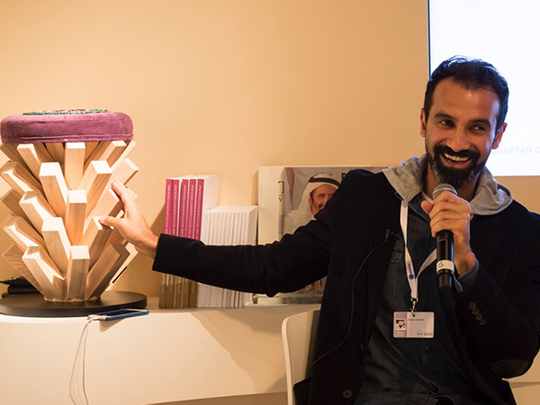
Dubai: Growing up, Emirati product designer Khalid Shafar was always fascinated with the beauty of the palm tree and the benefits for people who lived surrounded by them.
It was not just a tree that bore delicious dates, but rather a “sacred species” that represented a big part of UAE’s heritage and culture and held many untold tales of its past. Soon, the continuing fascination for the palm tree melded with his ambitions of becoming a designer and along with his growing awareness of his desire to revive UAE’s crafts, led him to make a life-altering decision. He would turn his long-held admiration of the palm tree into a mission to reveal the relationship between the ubiquitous tree and UAE’s artisanal craftsmanship. A key component in strengthening this relationship would be the role of Emirati craftswomen.
|
Inspirational tree A coat rack inspired by palm trunks is the highlight of Khalid Shafar’s Palm Line collection.
|
Five years into his profession as a designer, not only has he been able to create aesthetically functional objects that carry within them stories about UAE’s rich craft heritage, he is also ensuring that Emirati craftswomen find new oppurtunities for making a living from their skills.
This integration, Shafar believes, is crucial for posterity.
“I’ve always had an interest in exploring my own culture, background and origin to get inspired by ideas and stories I could reflect in my design,” said Shafar, whose gallery called KASA is a repository for his designs and their emblematic tales.
“Out of all [my] collections, the Palm Line collection mostly reflects [my] admiration [for the palm tree]. From the material to the shape, I was able to succeed in telling tales of the past through it,” said Shafar.
The Palm Line collection came into being when he realised how traditional Emirati craftswomen have used the dry leaves of palm trees to create handwoven objects, such as colourful mats to serve food on the floor. Palm trunks would be used as hangers for plastic bags and towels in Emirati homes.
“Craftswomen in the UAE were known for using a process called ‘Sarood’ to create those mats,” explains Shafaar. “As a tribute to the palm tree and UAE’s cultural crafts, I looked for Emirati craftswomen who were still creating traditional handwoven mats from dry palm leaves and commissioned them to provide me with the pieces.”
The Palm Line started with a coat stand inspired by palm trunks. This was followed by palm stools and tables with the traditional handwoven mats on top.
He made sure he did not interfere in the way the women made the mats to protect the purity of skills and expression.
“They come from a simple background and rely a lot on their instincts to develop the patterns and colours. The dry leaves were often dyed using spices before they were woven,” he explained.
There was also the matter of enabling this craft to be an income generator. Shafar said the women he commisioned would showcase their works to visitors and tourists at Heritage Village, but there was little income from it. “If local designers continue integrating them in their works, it not only secures more income for them, it also motivates them to continue keeping the crafts alive,” he said.
Shafar’s other works, which may not directly involve the efforts of the craftswomen, are equally symbolic of Emirati culture.
“A handmade rug I worked on was inspired by the shape of Talli, which is the traditional embroidery that has long adorned the cuffs and collars of women’s clothing in the UAE.” When people inquire about these products, he believes it’s a good way to educate them about UAE’s culture.
Shafar cited another example of being inspired by an essentially Emirati craft motif — the Kujoojeh — for designing a chandelier. “Women used to sit on the floor with a small stand called a ‘Kujoojeh’, a capsule-shaped cushion. On this, they knit the Talli in different shapes and colours by crossing and weaving the threads in intricate patterns. These simple traditional tools were the inspiration [for the design of the chandelier],” he said.
Shafar, who started out as a business graduate and then completed a degree in interior design and took courses in furniture design, wishes to continue integrating the skills of Emirati craftswomen with his works. It creates emotional satisfaction for him, he said, apart from highlighting his identity as an Emirati designer. “Knowing that what I’m doing is improving their lifestyle makes me happy.” he said. “The work they are doing is a big sign that simple people are able to create great works even without educational background or support.”
In October this year, Shafar accompanied the Dubai Women Establishment delegation and delivered a speech at the 11th Women’s Forum Global Meeting in France where he spoke about the role of folk art in modern design and his role in empowering Emirati women.
His session was a preview of things to come for the 2016 Women’s Forum in Dubai, the first of its kind in the region to highlight UAE’s achievements in women’s empowerment.
The forum is being co-organised by the Dubai Women Establishment.











